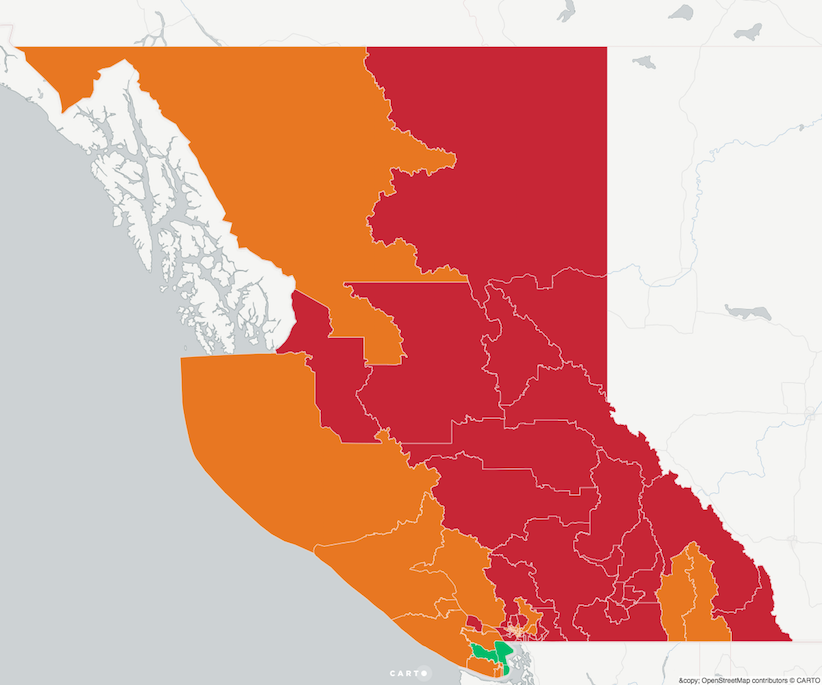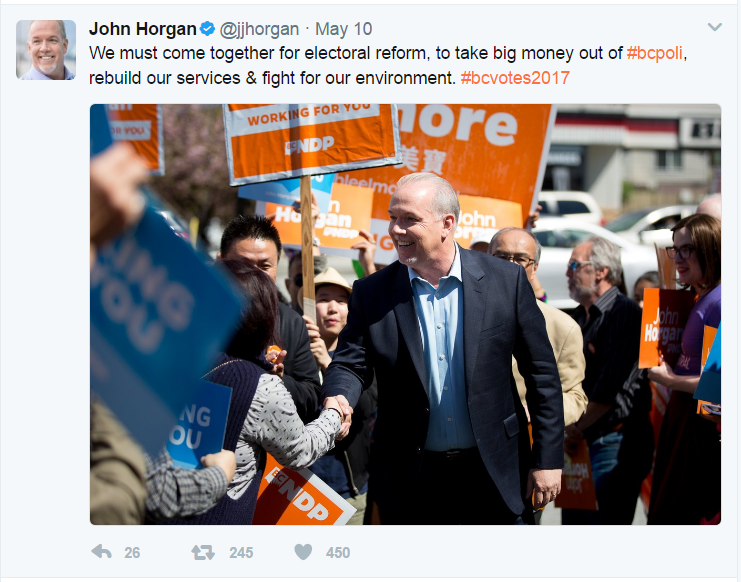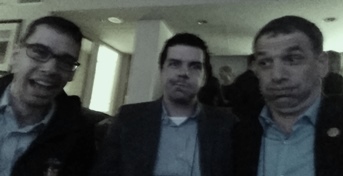Just for a change of pace, we had a relatively short meeting with a very long agenda. This happens when we have a smooth Public Hearing, no Public Delegations, and a fair amount of the Agenda being passed on Consent.
We had an open Workshop during the day, and I recently received an Ask Pat on one of the topics, so more talk on that then. The other topic is Integrated Stormwater Management Plan, which I could go on for hours about (as it somewhat intersects with my professional life) so I’ll save you the boredom and ask you to watch the video if you care!
The evening meeting began with a Public Hearing on a fairly large development in Queensborough:
Official Community Plan (Land Use Designation Amendment) for 1102, 1110, 1116 and 1122 Salter Street Bylaw No. 7916, 2017 and
Zoning Amendment (1102, 1110, 1116 and 1122 Salter Street) Bylaw 7917, 2017
This project will bring 78 units of (relatively) affordable family-friendly family homes to a large site in Queensborough that has been pre-loaded for a number of years, and will dedicate the waterfront portion of the adjacent properties to the City to continue our Queensborough waterfront trail. The unit mix (18 duplexes, 14 fee-simple row homes, 10 small single family detached homes, and 36 strata townhouses) provides a lot of housing variety, and the development is relatively dense for what is all ground-oriented housing. The development is within 5 minutes of schools, parks, and the commercial strip on Ewen Avenue.
We received a couple of delegations speaking in favour of the development (one was the architect, so no surprises there) and one in opposition. The opposing delegate was chagrinned by the loss of farmland in Queensborough, although this site has not been a farm for a very long time.
Council voted to refer these Bylaws to the Regular Meeting which immediately followed:
Official Community Plan (Land Use Designation Amendment) for 1102, 1110, 1116 and 1122 Salter Street Bylaw No. 7916, 2017
Council gave this OCP amendment Third Reading and Adoption. It is now the Law of the Land.
Zoning Amendment (1102, 1110, 1116 and 1122 Salter Street) Bylaw
7917, 2017
Council Approved this Zoning amendment, which essentially means we approved the development.
The following Items were Moved on Consent without discussion:
Intelligent City Innovation and Knowledge Workforce Committee Update
The Intelligent City initiative is rolling along, with several different parts of the overall plan being overseen by different City staff groups working with community members. The Innovation group are working on the development of an Innovation Hub in New West, and are working to bring some innovative use of technology to our Master Transportation Plan goals. They have also been instrumental in the development of our Open Data Portal, which is now award winning. The Knowledge Workforce group are working with local and regional education leaders to develop programs like last year’s successful Hackathon. There is a tonne more going on with this initiative, with more updates to come!
Appointment of an Acting City Clerk
There are some staffing changes at the City, and the role of City Clark is one that needs to be approved by Council, because they have a regulatory role under the Community Charter and delegated authorities under our Bylaw. We did so for the new Acting Clerk.
2016 Freedom of Information and Protection of Privacy Act Report
Our FOI requests are generally down (22% over the last three years), partly because of our becoming a more open organization (see award-winning Open Data portal, above). This is a good thing, as I think it demonstrates increasing trust in how the government operates. It is also good because FOIs take a lot of resources to manage, both to assure the data provided is complete, and also to assure that privacy issues are adequately addressed before data is released. Our response rate to FOI requests is also improved, which again saves us time and money.
320 Third Avenue: Heritage Alteration Permit No. 085 to Build New House in Queen’s Park – Consideration of Issuance
Because we are in the Heritage Control Period for Queens Park, a Heritage Alteration Permit is required prior to the issuance of a Building Permit for this house. The process this house went through is actually more rigourous than the one proposed for the Heritage Conservation Area Bylaw, but met almost all of the guidelines proposed for that process. The Technical Review Panel and Community Heritage Commission approved the design, and Council supported the HAP.
718 Twelfth Street: Temporary Use Permit 00014 to Allow an Institutional Use (Religious Worship) Within a Commercial District
The use of commercial spaces in the City for worship is closely regulated, for several good urban planning and business development reasons. As a general rule, the City discourages the use of commercial space for religious assembly. In this case, and organization is requesting temporary use for a small congregation as they are actively seeking a permanent location, and the proposed temporary use supports other uses of the site. Council granted this temporary use.
736 Sixth Avenue (7-Eleven): Development Variance Permit for Sign – Additional Information for Opportunity to be Heard
As mentioned last meeting, the conversion of the existing gas station uptown to a 7-Eleven location necessitates a variance of the sign bylaw, as their standard signage (which is actually smaller than what is currently there) does not fit the strict language of the Bylaw. Apparently, our notice of the opportunity to be Heard issued last week also required a bit of a language change to better reflect the variance. If you have a strong feeling about this signage, lease let us know by June 26th, when the Opportunity to be Heard will be held as part of regular Council.
2016 Annual Water Quality Monitoring Report
Every year, we get a report of the extensive testing of our potable water supply. Short version: the 744 samples taken in 2016 were clean and safe to drink. Bottoms up.
Investment Report to April 30, 2017
The City has about $136Million in various investments, and we have made about $1.0 Million in interest in those investments so far this year, tracking to a budgeted $2.6Million for the entire year.
Report on Major Purchasing Transactions for the Period January 1st to April 30th, 2017
Continuing on the theme of Open Government, here are all of the contracts larger than $100,000 that the City signed in the first third of 2017, and all of the Sole Source Awards larger than $50,000. If you bid and didn’t win, here is why.
Internet Service Provider Agreement with Surf Internet
Surf Net becomes the sixth vendor hoping to sell internet service though our BridgeNet dark fibre utility. How fast is *your* internet service?
National Health and Fitness Day Initiative
Check out the Fitness Day (June 3) offerings at the Centennial Community Centre, Canada Games Pool, Queensborough Community Centre, and Century House. I’ll be in Ottawa attending FCM, so please feel free to exercise on my behalf!
300 Salter Street (Port Royal): Development Permit and Development Variance Permit Applications for a Proposed 87 Unit Apartment Building – Development Permit for Consideration of Issuance and Development Variance Permit for Notice of Opportunity to be Heard
This four-story apartment building in Port Royal will require a variance to allow mezzanines and roof-top decks (which means it will be 12 feet taller than the zoning allows). There will be an Opportunity to be Heard on this variance on June 26th at Regular Council. C’mon out and tell us what you think.
630 Ewen Avenue: Official Community Plan Amendment and Rezoning from Queensborough Residential Dwelling Districts (RQ-1) to Comprehensive Dwelling Districts (630 Ewen Avenue) (CD-70) – Consideration of First and Second Reading
We are moving along with the process of developing a small affordable housing development in City-owned land in Queensborough. With this first and second reading, the OCP amendment and zoning will go to Public Hearing on June 26. C’mon out and let us know what you think.
600 – 720 Quayside Drive (Bosa Waterfront Site): Development Variance Permit – Notice of Opportunity to be Heard
Not burying the lede here, but this large development that will re-make the shape of our waterfront for a generation does not require a formal Public Hearing, as the Development Permit and Zoning are already completed. However, the shape of the buildings has changed, and it does require several variances: for height, building footprint, and parking layout. There will be an Opportunity to be Heard on June 26th. This is your chance to come out and tell us what you think about this development.
Advisory Committee for Transit, Bicycles and Pedestrians (ACTBiPed): 30 km/h Speed Limit on Designated Greenways, Bikeways, and Streets That Do Not Allow Cycling on the Sidewalk
Cars going 30km/h are significantly safer in our residential nieghbourhoods (and everywhere) than cars going 50km/h. Unfortunately, the Ministry of Transportation makes it difficult for local governments to regulate safe speeds in our communities, because they think 50 is nifty. In character with our Master Transportation Plan, the City is working towards bringing 30km’h in the most appropriate places where it will have the largest safety benefits. We will be phasing in 30km/h along greenways where we are encouraging cyclists an pedestrians, and in the areas of the City where the Street and Traffic Bylaw makes it illegal to ride on the sidewalk (primarily Uptown, Downtown, and Sapperton business districts). It is a start, and perhaps with a potential change in Government in Victoria, we will have more support to make it easier (and more cost effective) to make our nieghbourhoods safer for pedestrians.
The following Items were Removed from Consent for discussion:
Shaw TV community television station ceasing operations in Metro Vancouver and partnering with Global News for local programming
My TV career is coming to an end. Shaw is getting out of its requirement to cover local government council meetings in Vancouver, Calgary, and Edmonton markets. By the end of summer, our Council Meetings will no longer be televised. It was, frankly, a declining audience, and probably inevitable. Maybe we needed to do more product placements…
The good news is that this may be the impetus we need to update our live and recorded video streaming service. The SilverLight®-dependant and slightly clunky interface we currently have is not exactly state-of-the-art, and I am hoping we can have a product that not only streams on more devices and through more browser types, but has search functions and links portions of the evening’s Council to agenda items so people can zoom to the part of the meeting that they care about. Hopefully good things to come by the end of the summer (and we can release Wes of his http://newwe.st/open-council/ responsibilities).
New Westminster Age-Friendly Community Strategy
The City collaborated with graduate students at UBC’s Sustainable Community and Regional Planning (SCARP) program to develop this comprehensive strategy. They presented to us some great demographic research, and provided a great set of guidelines and strategies to help us adapt to the upcoming demographic certainty of an aging (and healthy-into-older-age) community. These strategies will help us develop the services needed to for seniors to stay engaged in their community, assure our built environment makes it easier for seniors to live in an navigate through our community, and to partner with service agencies and senior governments to provide the necessities of life like appropriate housing, access to healthcare, and peer support. I’m really proud of the work our Staff did here with SCARP.
425 East Columbia Street: Temporary Use Permit for Arcade – Notice of Opportunity to be Heard
I’m happy we found a way to accommodate this use, but I am afraid we are still holding onto some of the moral panic issues that led to strict restrictions of arcades on the 90s. I don’t understand why we think people can responsibly drink a beer, we think people can responsibly play Pac Man, but if we let people do both at the same time, trouble is inevitable. However, this Temporary use Permit may help us address some of the potential conflict issues while we try this on for size. There will be an Opportunity to be Heard on this temporary use, please come out June 26th and let us know what you think.
Finally, we went through the Bylaws Shuffle:
Official Community Plan Amendment Bylaw (612 – 618 Brantford Street) No. 7876, 2017
Heritage Revitalization Agreement Bylaw (612 – 618 Brantford Street) No. 7886, 2017
Heritage Designation Bylaw (612 – 618 Brantford) No. 7885,2017
These three Bylaws that support the development of a 6-story residential development and protection and restoration of a heritage home in the Brow of the Hill saw Third Reading on January 30th, and are now adopted by Council. Please adjust your behavior accordingly.
Heritage Revitalization Agreement Bylaw (1407 Sixth Avenue) No. 7807, 2016
Heritage Designation Bylaw (1407 Sixth Avenue) No. 7806, 2016
These Bylaws that support the subdivision of a property to facilitate the protection and restoration of a heritage home and building of a second house in the West End saw Third Reading on February 29, 2016 (!) and is finally ready for adoption. It is now the Law of the Land.
Zoning Amendment Bylaw (518 Ewen Avenue) No. 7833, 2016
This Zoning Amendment to change an archaic commercial zones property to residential to facilitate the building of a single family home in Queensborough was given third reading on April 24, 2017, and is now law.
Official Community Plan (630 Ewen) Amendment Bylaw No. 7919, 2017
Zoning Amendment (630 Ewen Avenue) Bylaw No. 7920, 2017
The zoning changes to support the small affordable housing project in Queensborough was given two readings. The Public Hearing on June 26th will be your chance to come on out and tell is what you think.
And except for singing Happy Birthday for the seconds time in as many months at Council, we were done for the day.


